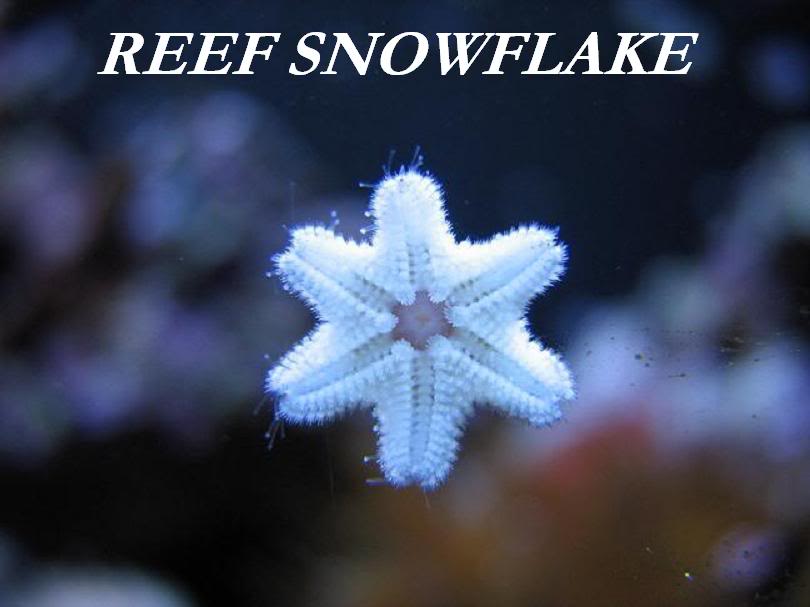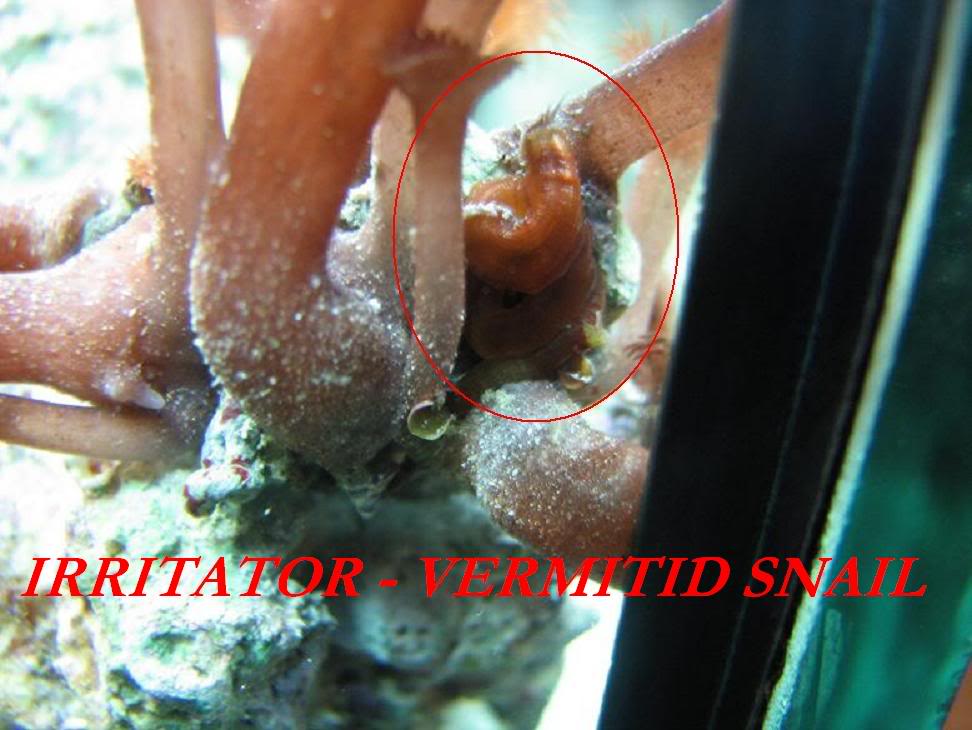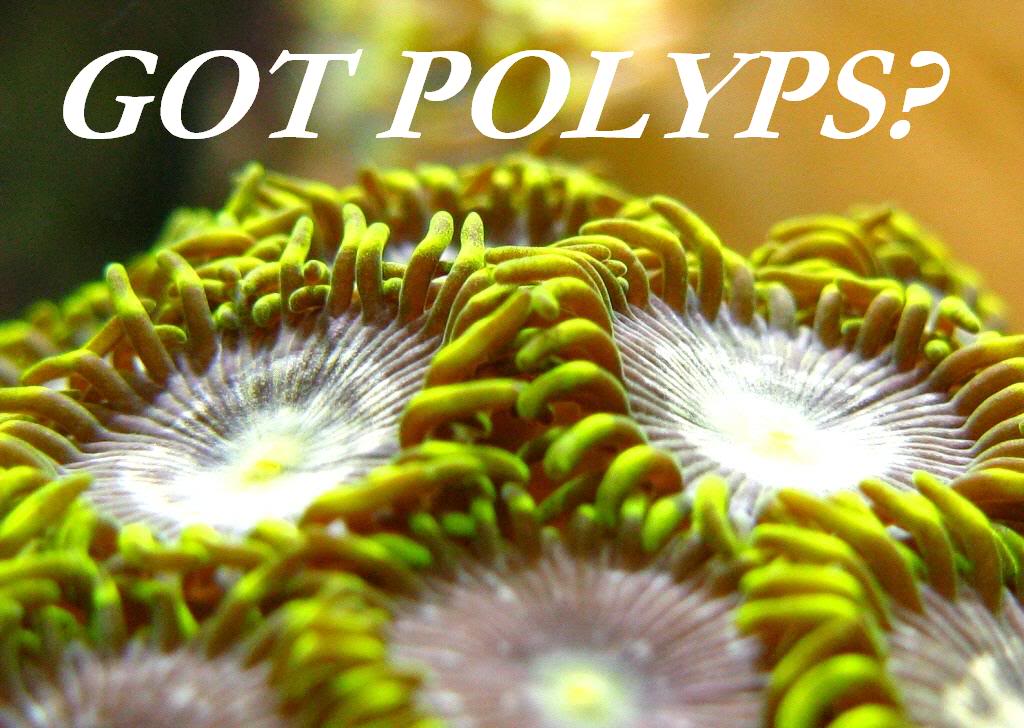ZOANTHID CARE AND PROPAGATION
There seems to be a great deal of resources available for SPS corals but the information on Zoanthids seems to be less comprehensive and harder to find. Zoanthids can be a finicky coral and they can be difficult to keep colorful and growing, not unlike the SPS corals.
What are the primary needs for Zoanthids? Good lighting, organics, nutrients, good water chemistry and the absence of pests.
LIGHTING:Zoanthids are very adaptable and can do reasonably well in many conditions. However, it is my opinion that Zoanthids do like good lighting. This is evidenced by the "morphing" of polyps that are low in the tank or in a shaded area. Often they will expand larger, have duller coloration and grow exaggerated stalks from stretching toward the light. High lighting is the best for most, though I have had success in low to medium lighting as well. I have even noticed that certain species or colors prefer higher or lower light.
 WATER MOVEMENT:
WATER MOVEMENT:Zoanthids do not require the consistent high flow conditions that SPS corals prefer. I would consider a moderate flow environment ideal but Zoanthids, like most corals, can adapt to low or high flow. In high flow, you will typically see polyps grow closer to the rock with shorter stalks.
DISSOLVED ORGANICS & NUTRIENTS:Unlike most SPS corals, Zoanthids can thrive in a higher nutrient environment but they can also do well in a lower nutrient environment. If you want Zoanthids to show their brightest colors, grow steadily and stay open regularly, feed your tank a varied diet on a regular basis. I have learned that infrequent feeding and ultra low nutrient conditions can lead to entire colony meltdowns. The "cheesing out" syndrome can be the result of limited nutrients (Phosphates, Nitrates). Zoanthids need fish poop, dissolved food matter and the resulting nutrients to thrive.
In my experience, Zoanthids can thrive in the same conditions that SPS corals do. Good dissolved organics levels, high light, good nutrient export, low nutrient byproducts like Nitrates and Phosphates. I am not claiming that Zoanthids need the pristine conditions that SPS corals require but they do thrive in similar conditions. However, I have learned from experience that Phosphate levels below .02 can be detrimental to the health of the polyps. Always remember that Nitrogen and Phosphorus are the building blocks for coral life, so zero Nitrate reading or zero Phosphate reading are not a good thing for your aquarium life.
WATER CHEMISTRY:Zoanthids do not require the level of, or the amount of, trace elements that SPS corals do but they certainly benefit from consistent water quality/chemistry. Qualities that should be monitored regularly in a reef aquarium are -- Alkalinity, Calcium, Magnesium, Iodine, temperature, Phosphates, Nitrates, and pH. I am not indicating that they require all of the aforementioned items specifically, only that consistent levels keep Zoanthids happy and healthy. My chemistry is consistently maintained in this range:
dKH: 8.0 - 9.0 (via Kalk drip)
Calcium: 420 - 440 (via Kalk drip)
Magnesium: 1250 - 1350
Iodine: Maintained via regular water changes (be careful if you are dosing without testing!)
Temperature: 79 - 80 degrees
pH: 8.1-8.2 (reverse lighting schedule for refugium)
Phosphates: .02 - .03
Nitrates < 5
TARGET FEEDING:Target feeding is not a requirement as Zoanthids are photosynthetic. I have found that target feeding Zoanthids always provides mixed results, when a food particle falls onto the polyps. The Palythoa species of polyp seems to show a feeding response much more consistently. I do attempt to feed polyps on my frag rack, to enhance growth, while the flow is turned off. I judge the target feeding benefits by the individual species’ response. A polyp that welcomes meaty bits will typically close around food particles and “catch” them with their outer fringe. If they don’t participate in that manner, then you are simply adding excess food and nutrients into your system.
PREDATORS, PESTS, DISEASE AND OTHER STRESSORS:I will spend a good deal of time on this item, as certain pests can destroy a colony of Zoanthids in a very short period of time. I have experienced many personally and I will share a recent occurrence.
Sun Dial Snails --One day I noticed that one of my "Pink Panther" Zoanthid colonies were about 25-30% closed. Hermit crabs or snails will often venture across a colony and cause it to close up, so I didn't think much about this initially. The next day, I noticed that the same section of the colony was closed. What was going on? I started to look more closely and saw a Sundial Snail happily sucking the life out of my colony. The nerve! I quickly removed the snail and thought that I solved the problem. A day later, the colony was close to 50% closed. What the heck?!! Finally, I pulled the entire colony out and discovered a second Sundial Snail snacking on the lower portion of the colony. This colony ultimately made a full recovery. I am not quite sure where the Sundial Snails came from but they may have came into the aquarium in the form of a snail egg. Here are a few pictures from the incident --


 Marine Fish --
Marine Fish --Use caution when adding fish that have a reputation for munching corals. Angel Fish can be particularly fond of Zoanthids and may obliterate a tank full in a couple of days. I once bought a Foxface Rabbitfish that developed a taste for green zoanthids. Over the period of a few days, the fish devoured several HUNDRED polyps! Initially, the fish was a perfect resident and did nothing but keep the rockwork free of green algae. That changed quickly!
 Zoanthid Eating Nudibranchs --
Zoanthid Eating Nudibranchs --These little guys are really hard to spot unless they make an occasional trek up your tank glass. Some are really tiny. They naturally blend in with the Zoanthids and will sometimes take on the bright color of their snack. To remove these pests, I dip frags/colonies a solution of Lugol's Iodine and fresh water (RO/DI). If you discover any Nudi's, assume that there are eggs somewhere on the colony. Quarantine the colony for 7-10 days and dip it a couple of more times. The dip is only effective on offspring, not on the eggs, hence the need to quarantine and await the hatch cycle. Here are some pictures of Nudi's removed via dip and some eggs left behind --


 Zoa Spiders --
Zoa Spiders --I have not had a personal experience with these suckers but they can be devastating to a Zoanthid colony. If a dip reveals any of these ugly little guys, quarantine and handle as you would the Nudibranchs.
 Asterina Starfish --
Asterina Starfish -- I have never had a major problem with Asterina but I do occasionally find one on a polyp and remove it. It seems that that there is a specific strain of Asterina that can be extremely predatory and prefer corals like Zoanthids. Some folks feel that they are simply taking advantage of an unhealthy polyp. Here is a shot of one that was feasting on a Palythoa polyp --

 Zoa Pox --
Zoa Pox --This is a condition where the underside of the polyp and the stalk incur raised white bumps. Not enough is truly known about Zoa Pox but there are many proposed remedies. Fresh water dips, Lugol's dips, leaving the colony exposed to the open air for extended periods of time, high flow, etc. I had a minor issue in my nano tank but the good water quality and high flow rectified the issue. Some claim that this is a condition that can spread amongst an entire Zoanthid population but I did not have that experience.
 "Diseases" --
"Diseases" --Many debate whether or not there truly are diseases like Zoa Pox, invasive Fungus, etc. I have experienced "melt downs" and colonies that have "cheesed out". Fungus? Affects of Allelopathy (chemical warfare)? Low Nutrient levels? Contaminant? Hard to say but I would point to water quality, low nutrients or chemical warfare.
Stressors --Stressors can include Allelopathy (chemical warfare), Vermitid Snails, Spaghetti Worms, Spionid Worms, Amphipods, Copepods, Foraminiferans and pest Anemones (Aiptasia, Majano). Constant agitation can lead to stress and eventually the death of polyps. This is not real common in my experience but a combination of stressors or a plague of the above critters could become overwhelming.


 TROUBLESHOOTING:Are your Zoanthids closed up tight and being shy? Here are several things that you should consider or be aware of:
TROUBLESHOOTING:Are your Zoanthids closed up tight and being shy? Here are several things that you should consider or be aware of: Pests – Always check unhappy polyps for pests. Sundial snails are sneaky and will hide in crevices or on the bottom side of rocks. Inspect between the polyps very carefully and use a turkey baster to flush the polyps thoroughly during dips.
Lighting acclimation – If your new Zoas have come from a low light environment, the sudden introduction of intense light can stress the coral out and cause it to shut down. In this case, add this coral into a shaded area for a week or two, in order to allow for acclimation.
Low Nutrients – The lack of Nitrates or Phosphates in a system can cause your Zoas to shrink up and become unhappy or even melt away. A brand new set up can be very low in nutrients, so be aware that this can be an issue. If you determine that your nutrients are low, increase feeding or decrease the export of said nutrients.
Allelopathy (chemical warfare) – Growing Zoas into a tight “garden” is an extremely challenging task. Though they may be the same type of coral but Zoanthids do not always appreaciate neighboring polyps when they begin trying to occupy the same space. At various times, I have seen a rapidly growing colony tangle with the wrong neighbor and as a result, the whole colony withered away and dies.
Flow - I often find that a finicky colony will benefit from higher flow. If you have a frag or colony and can’t seem to get them to open fully, put them in a higher flow area. If you have tried everything else, try higher flow.
Location in your tank – If your Zoanthids are just simply unhappy, try a different spot in the tank. Higher, Lower, more light, less light, etc.
Helpful Links and Resources:
ZoanthidHlthFAQs
Zoanthid Predators, Irritators, & Diseases
CoralPedia.com! :: The definitive repository for named Corals!
CoralPedia.com! :: The definitive repository for named Corals!
Reef 2 Reef :: Bringing Reefers Together Worldwide
Foraminiferans by Ronald L. Shimek, Ph.D. - Reefkeeping.com



